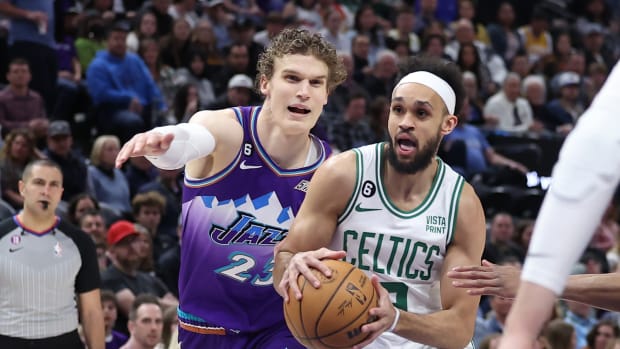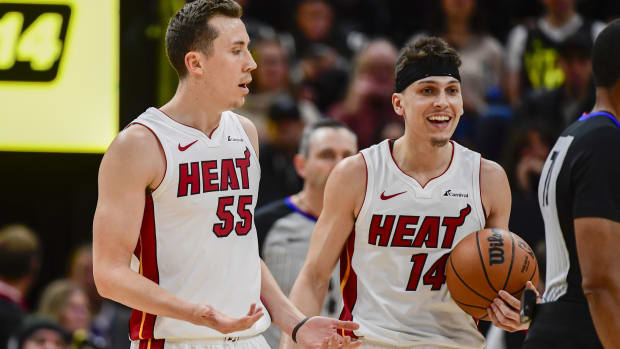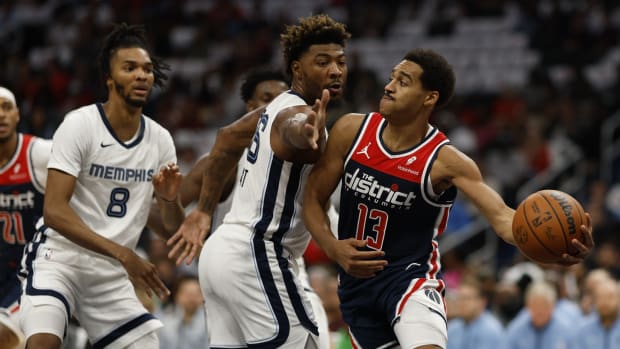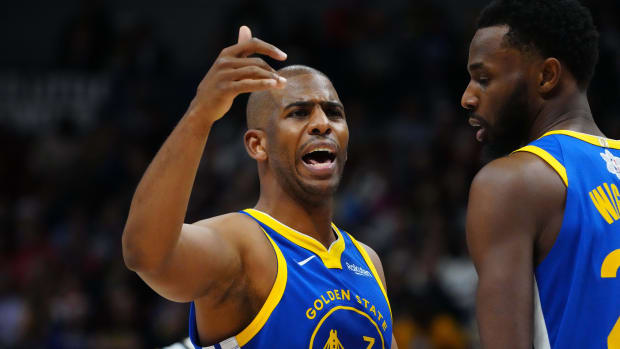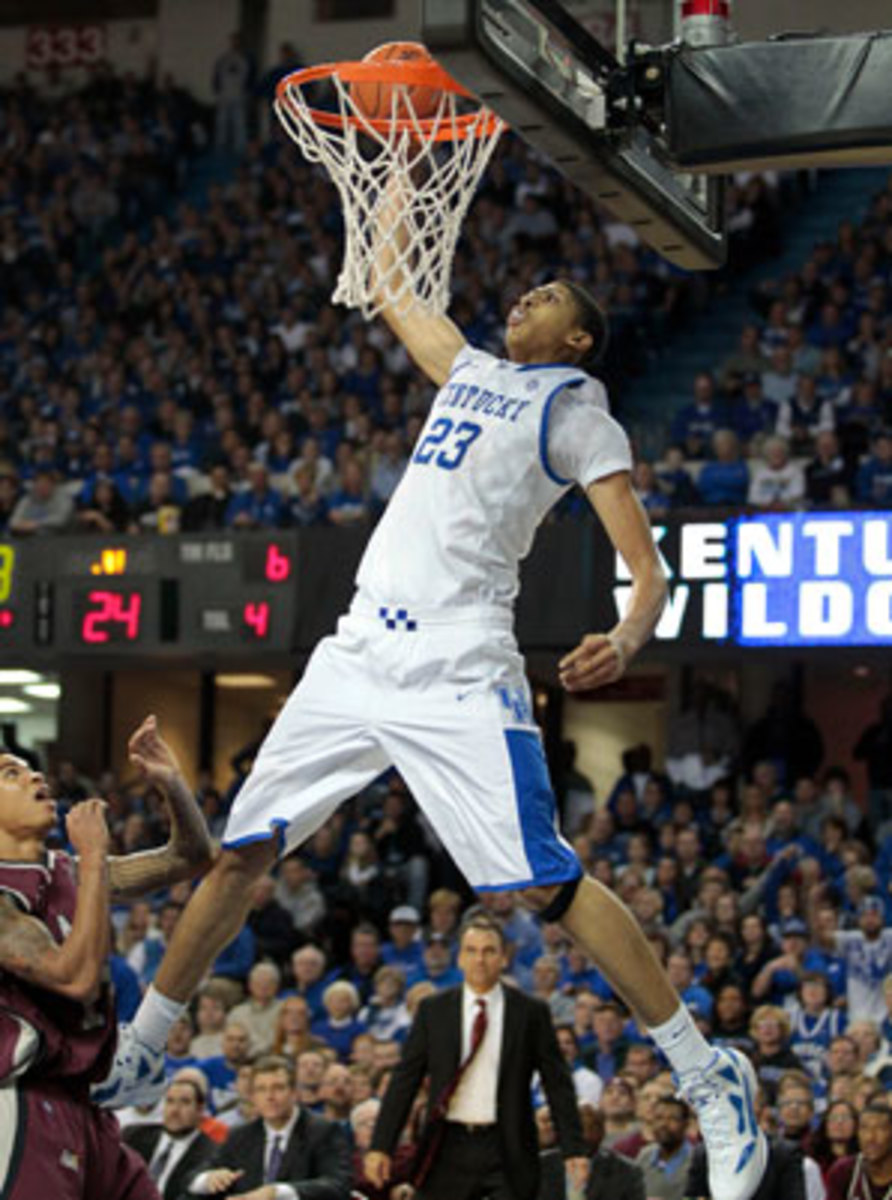
2012 NBA draft stock watch
Midway through the college basketball season, here's how 14 players stack up in the eyes of NBA scouts.
(Statistics through Jan. 8)
Anthony Davis, PF6-foot-10, 220 poundsFreshman, Kentucky
A foul-plagued performance against Indiana aside, Davis has been a monster in the middle for Kentucky. He's been a shot-blocking phenom, swatting an NCAA-best 4.6 per game, and a double-double regular, notching 10 in the Wildcats' first 17 contests. Perhaps most significant, he's displayed a precocious learning curve, taking advantage of his massive frame -- and maintaining proficient ball-handling skills -- far better than expected for someone who experienced an eight-inch growth spurt during his junior year of high school.
"I think it's a great asset to not only have those [perimeter] skills, but to still use them," an NBA talent evaluator said. "He seems to have retained enough of them, which I think will really help him in the future."
Though his slender frame remains an issue, his relentless work ethic, budding post presence and 7-foot-4 wingspan are nearly unparalleled.
"My comparison for him is always Kevin Garnett," the scout said. "He got bigger and stronger, but he never got to 275 or anything, and I don't think [Davis] will get there either. He'll probably be more of a jump shooter, defender, shot-blocker, rebounder and capable scorer. I think his future is unlimited."
Put simply: Davis has the makings of a franchise player and should be considered a top pick candidate heading into the June draft.
Jeremy Lamb, SG6-5, 180Sophomore, Connecticut
Amid Kemba Walker's heroics, something went overlooked in UConn's run from 21-9 bubble-dweller to NCAA champion last March: Jeremy Lamb is really good. The guard averaged 15.3 points in the Big East and NCAA tournaments, and this season he's thrived in Walker's absence. He's averaging 18.2 points in his second year (up from 11.1 as a freshman), earning a reputation as one of the nation's premier scorers.
"He scores 1,000 different ways," a talent evaluator said. "He can make runners and floaters and pull-ups and threes and can score in traffic."
Lamb boasts a 51.3 field-goal percentage (39.6 percent from three-point range), but has struggled to get to the free-throw line, averaging 3.1 attempts per game. If he can increase that number and add some muscle to his lanky frame, look for him to secure a spot among the 2012 draft elite.
Michael Kidd-Gilchrist, SF6-7, 210Freshman, Kentucky
Though Davis is Kentucky's most touted prospect, Kidd-Gilchrist could be the most valuable. He has anchored the Wildcats' early success, with his performance against Louisville serving as a prime example: He amassed 24 points, 19 rebounds and 13 free-throw attempts in a 69-62 victory on Dec. 31.
Kidd-Gilchrist's on-ball defense is tenacious, and he's a predominant reason Kentucky is holding opponents to an NCAA-low 34.7 percent shooting. Best of all, though, he's a proven winner. According to an NBA scout, he's boosted his stock to the mid to late portion of the lottery -- likely in the eight-to-14 range -- thanks in large part to his striking unselfishness.
"The greatest compliment I could give this kid is that I think he's the best winner on their team," the scout said. "Everybody tells you they want to win, but they always want to win on their terms. My impression is -- because this is what he was like in high school -- if he gets three points and they win or he gets 30 points and they win, he's really happy. He's going to do whatever it takes to get them there."
Jared Sullinger, PF6-9, 270Sophomore, Ohio State
Traditionally, the knock on Sullinger has been his athleticism, with scouts worried that his lack of explosiveness could pose problems in the increasingly fast-paced NBA. His size also raises concerns, with one scout saying, "He's listed at 6-foot-9 -- I want to know if he's 6-foot-9. I want to be in the room when they put the tape measure on this guy."
Here's the thing: After averaging 17.1 points and 9.6 rebounds through Ohio State's first 17 games -- and registering a 35.5 Player Efficiency Rating, fourth in the nation -- he's proved that his polished low-post repertoire more than makes up for his lack of highlight-reel plays. His back-to-the basket savvy, at the college level at least, is simply unmatched.
His best asset may be his motor. While most players fade toward the end of games, the big-bodied Buckeye has only emerged stronger, averaging 9.5 points and six rebounds in the second half of his first four Big Ten games.
"He's just so strong," a talent evaluator said. "He gets the rebounds that count. He gets the 'man' rebounds. You win with those rebounds."
He's viewed as a top-six pick in June.
Cody Zeller, C6-11, 210Freshman, Indiana
A revelation on resurgent Indiana, Zeller has owned the interior as a freshman. He's a defensive wunderkind -- averaging 1.7 steals and 1.5 blocks -- and has been even better offensively: He ranks among the top 10 nationally in PER (31.5) and field-goal percentage (65.6).
He also does the little things right, compensating for his lack of athleticism with terrific positioning and intangibles. He gets the foul line consistently, averaging 4.75 attempts per game, and most important, has keyed Indiana's newfound success. The Hoosiers are the surprise of the season, and Zeller's impact -- as a scorer, rebounder and defensive presence -- isn't lost on scouts.
"They haven't won the last couple of years, and all those guys were there," a talent evaluator said. "Then this kid comes along and look where they are. He has a huge impact on what they do."
The scout added: "Is he going to be a star in our league? Probably not. Because he does have some athletic limitations. But if he's on your team, you're probably going to be pretty good. He has a lot of value."
Fab Melo, C7-0, 275Sophomore, Syracuse
Largely undeveloped entering the season, Melo has transformed into a defensive star for top-ranked Syracuse. He ranks among Big East leaders in blocks (2.9) and defensive rating (91.3), and has increased his scoring of late, netting double figures in wins over Seton Hall, DePaul and Providence. After a maddeningly inconsistent freshman campaign, he's finally shown signs of becoming the impact performer he was touted to be in high school.
The most telling sign of Melo's maturation is his playing time. The 7-foot Brazilian averaged 9.9 minutes last year, playing 20 just twice in 33 appearances. This season, he's played 20 minutes in 13 of 17 games, and -- though raw -- has wowed scouts with his commitment to conditioning.
"He just couldn't play extended minutes last year," a scout said. "He seemed to get tired and I don't think Jimmy [Boeheim] trusted him in the game. Now, he's lost a significant amount of weight and is much more active and blocking shots. It tells us something about him. He was willing to work and it's really helped him."
Harrison Barnes, SF6-8, 210Sophomore, North Carolina
A top-five candidate had he entered last year's draft, Barnes, for the most part, has been as good as advertised in his ballyhooed sophomore effort. He built off a strong finish to last season -- one in which he averaged 24 points from January through March -- by demonstrating more aggressiveness, upping his free-throw attempts from 3.4 to 4.8 per game. He's also stood out by increasing his three-point percentage from 34.4 to 51.2.
Other than his range, however, Barnes has done little to distinguish himself as the top player in this year's class. He's shown limited passing and ball-handling ability, and at times, seems defensible.
"He's not one of those guys that you throw him the ball, isolate him and he's going to dribble-drive you," a talent evaluator said. "Don't misconstrue what I'm saying -- I'm not comparing him to anybody -- but the elite wings in our league can all really handle. The Kobes and LeBrons and Dwyane Wades and Paul Pierces -- you throw them the ball and let them do their thing. Right now, he doesn't have that."
His stock certainly hasn't fallen, but it hasn't skyrocketed either. For now, he appears primed for a top-five selection.
Perry Jones III, PF6-11, 235Sophomore, Baylor
Since returning from a five-game suspension for accepting improper benefits last year, Jones has been an enigma of sorts for unbeaten Baylor. He's averaged 13 points on 52.9 percent shooting but has played inconsistent defense and done a so-so job on the glass, averaging a pedestrian 7.2 rebounds despite his size.
At 6-11 with freakish athleticism, Jones is viewed by many as a top-10 pick, with his potential evident in outings against Prairie View A&M and BYU (a combined 55 points, 21-of-30 from the field). After uninspired showings against Mississippi State and West Virginia (12 points total on 6-of-22 shooting), however, questions have emerged as to why Jones isn't putting up All-America-type numbers.
"Players that are that talented, we just want him to be more dominant," an NBA scout said. "But our league is notorious for drafting on upside. It'd be hard to be staring at that guy and not think what's he going to be like three, four or five years from now. He's just too seductive."
The bottom line: Jones' production leaves something to be desired, but his deliverables and freakish athleticism may be too tantalizing to pass up. He remains projected in the top three in most mock drafts, and seems an early lottery lock if he declares.
Andre Drummond, C6-11, 275Freshman, Connecticut
Few players have experienced a more eventful five-month span than Drummond. Slated to play for Wilbraham & Monson (a Massachusetts post-graduate prep school) in August, he changed his mind and committed to UConn, drastically altering the NCAA landscape, and in turn, the projected 2012 draft order. His appeal is clear: "He passes the eye test," a Western Conference scout said. "The old adage is you can't teach size and athleticism."
Problem is, he hasn't taken full advantage of his NBA-ready frame. He's been unwilling to body up -- he's drawn comparisons to Amar'e Stoudemire for his tendency to linger around the perimeter -- and has struggled on offense, scoring just 14 points, and racking up eight turnovers, in back-to-back losses to Seton Hall and Rutgers. He runs the floor well, but as with Jones, he's lacked consistency with his back-to-the-basket and perimeter games.
"I think the more you see him, you see more deficiencies as far as skills go," the scout said. "I think you might see that you have a bigger project than you anticipated, especially because the level of competition is going to be higher now that we're in league play. He needs a lot of individual skill work."
Terrence Jones, PF6-8, 240Sophomore, Kentucky
Beginning with his inexplicable performance Dec. 10 at Indiana (four points, one rebound), Jones has been a near nonfactor in the Wildcats' subsequent seven wins. He missed games against Samford and Loyola (Md.) with a finger injury, and scored just 11 points on 5-of-19 shooting in meetings with Lamar and Louisville. After averaging 5.1 free-throw attempts in his first seven games, he's averaged three in his last eight, shying away from the aggressive brand of basketball that spurred his stock in the first place.
That said, his stock hasn't plummeted as far as many analysts have speculated. Jones routinely poses mismatches, driving past slower big men in the lane, and suffers from a John Calipari-coached system that spotlights team over individual success (six players are averaging between 10.2 and 14.6 points). In the latter case, box scores don't tell the entire story.
"If he's at Washington State -- he's a Seattle kid -- he never comes off the floor," an NBA scout said. "Maybe he's a 20-10 guy and we're like, 'Oh, my God.' But at Kentucky? They're too good. He gets eight, nine or 10 shots per game instead of 17, 18 or 19. There's a big difference."
Jordan Taylor, PG6-1, 195Senior, Wisconsin
Wisconsin's recent three-game skid is just the latest disappointment in Taylor's underwhelming senior campaign. The preseason All-America -- who led the nation with a 3.83 assist-to-turnover ratio last year -- has been uncharacteristically ineffective, watching his field-goal (39.5) and three-point percentage (33.3) dip as his turnovers reached the highest totals of his college career (1.7 per game). Lacking the size and speed of most pro-ready guards, his shaky play has raised doubts about his ultimate NBA potential.
Taylor remains a proven decision-maker, and possesses a strong, compact frame that allows him to outmuscle opposing guards. But given his senior setbacks, he seems to lack the athleticism to merit a first-round pick.
"I think that teams would view him as a really good backup point guard as opposed to handing him the ball and letting him run a team and play up and down for 38 minutes," a talent evaluator said. "I just don't view him as that kind of player."
Joshua Smith, C6-10, 320Sophomore, UCLA
A five-star talent out of Kentwood High (Wash.), Smith has failed to meet to expectations during his two (and possibly only) years in Westwood. He's been more space-eater than sensation, averaging just 9.9 points and 5.3 rebounds as a sophomore. He's also struggled to keep pace defensively, with his presence in the paint -- or lack thereof -- playing a role in the Bruins allowing opponents to shoot 42.6 percent, a lowly 170th in the nation.
His biggest issue remains his weight. At 320 pounds, Smith lacks the mobility to hang in the up-tempo NBA, prompting questions about his stamina and long-term potential. It also serves as a stinging indictment of his work ethic -- something that could come back to haunt him come draft day.
"You're thought process is, if this was really important, lose 20 pounds and try to tighten up a bit," a scout said. "He didn't do that. It raises a red flag as to what his thought process is and if he'll ever get into great shape."
Josiah Turner, PG6-3, 185Freshman, Arizona
A trendy draft sleeper entering the season (he was once projected as high as the 18th pick by NBADraft.net), Turner has been far from the difference maker that many envisioned him to be. Not only has he failed to live up to his reputation as a distributor, averaging just two assists, but he's also been a subpar scorer, with only 7.2 points. He's started only once, in the season opener against Valparaiso, and remains mired on the bench behind Jordin Mayes, Kyle Fogg and Nick Johnson.
More troubling: The 19-year-old was suspended for violating team rules before a clash with 12th-ranked Florida, the reason speculated to be a lack of participation during practice. That's not exactly a ringing endorsement for one-and-done NBA success.
Trevor Mbakwe, PF6-8, 240Senior, Minnesota
The most disheartening case in the group, Mbawke's stock tumbled after his Nov. 27 ACL tear, effectively ending his college career. Since transferring from Marquette and Miami-Dade Community College, the big man had emerged as one of the nation's premier rebounders, averaging 10.3 boards (and 3.3 offensive rebounds) in 38 games since the start of his junior year. He was thought to have an outside shot at the first round with refined footwork, a possibility that may have dissipated following reconstructive surgery on Dec. 30.
As questions abound, Mbakwe could slip to the latter half of the second round. That is, if any team is willing to take a chance on him at all.































